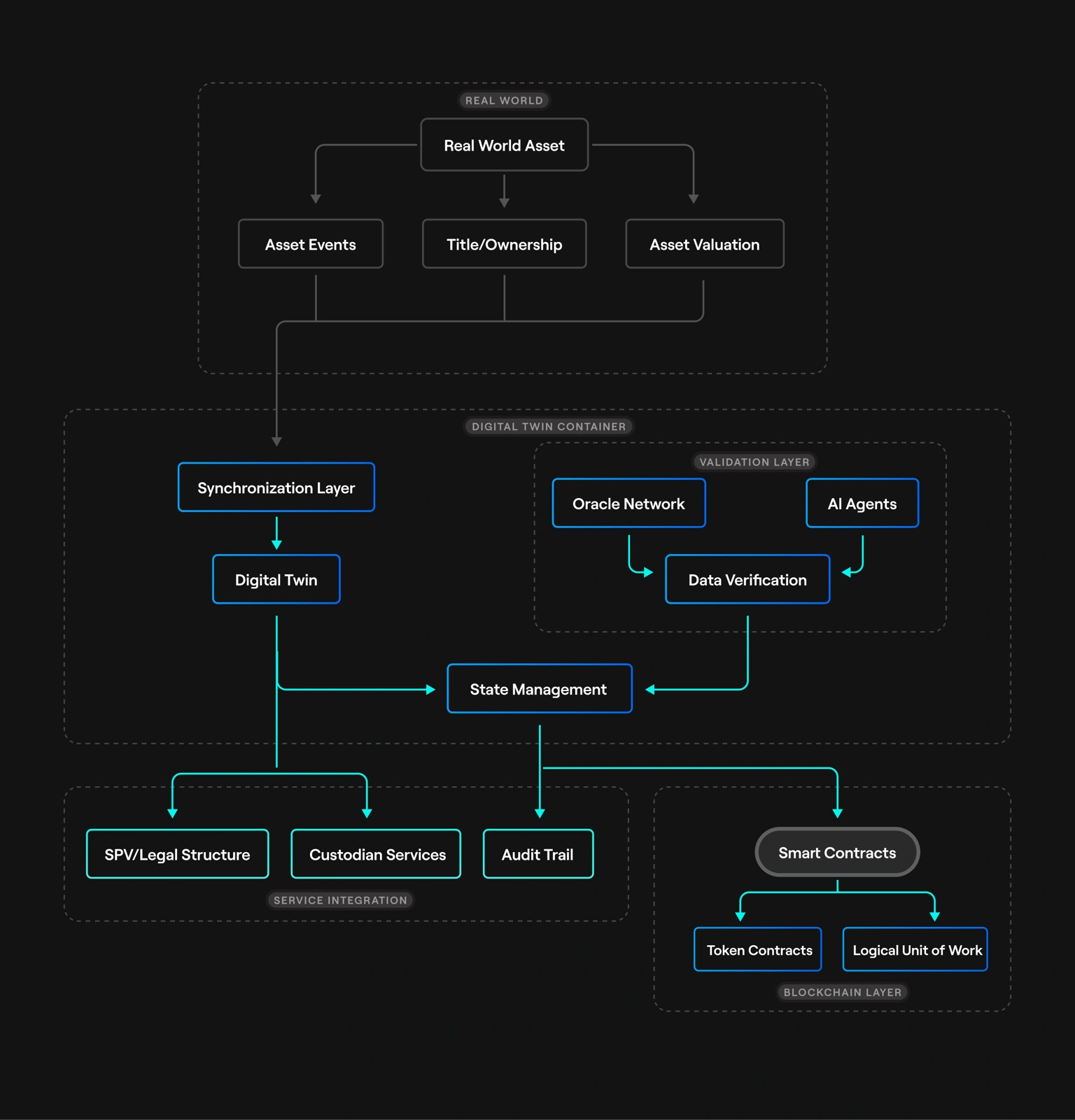위키 구독하기
Share wiki
Bookmark
Novastro
Novastro
Novastro는 실물 자산(RWA)의 토큰화를 위해 설계된 금융 기술 플랫폼이자 모듈형 인프라 계층입니다. 이 플랫폼은 인공 지능, 모듈형 원장 및 규정 준수 중심 프레임워크를 활용하여 물리적 자산과 전통적 자산을 유동적인 크로스체인 디지털 상품으로 전환하는 것을 목표로 합니다. 1 2

개요
Novastro의 핵심 임무는 실물자산(RWA) 토큰화, 거래 및 수익 창출을 위한 포괄적인 생태계를 구축하여 전통 금융과 탈중앙화 금융(DeFi)을 연결하는 것입니다. 이 프로젝트는 "한 번 토큰화하면 어디서든 거래"라는 원칙에 따라 여러 블록체인에 걸쳐 인프라를 확장하고 상호 운용성을 강조합니다. 디지털 토큰이 기반이 되는 실물 자산의 법적, 재정적, 운영적 무결성을 유지함으로써 RWA 시장을 실험 단계에서 기관 규모로 발전시키는 것을 목표로 합니다. 이 플랫폼은 기관급 투자 기회를 제공하며, 이러한 자산을 거래하기 위한 24시간 글로벌 시장을 포함합니다. [2] [1]
플랫폼 개발은 Novastro 팀이라고 불리는 기관들에 의해 이루어졌습니다. 공식 문서에서는 Bhavish Labs Global Ltd.를 관련 회사로 명시하고 있지만, 주 웹사이트에서는 운영 기관을 Novastro Labs, Inc.로 언급하고 있습니다. 2025년 9월 기준, 이 플랫폼의 애플리케이션은 테스트넷에서 사용할 수 있으며, 사용자는 비생산 환경에서 기능을 사용해 볼 수 있습니다. [3] [1]
제품 및 생태계
Novastro는 RWA 토큰화 플랫폼을 중심으로 투자자와 자산 관리자 모두를 위한 제품 및 서비스 제품군을 제공합니다.
RWAfi 플랫폼:
실물자산(RWA)을 토큰화, 관리 및 거래하기 위한 포괄적인 인프라입니다. [1]
- 24/7 글로벌 마켓플레이스: 사용자가 다양한 토큰화된 기관급 자산을 발견하고, 투자하고, 거래할 수 있는 상시 운영 마켓플레이스입니다. "몇 분 안에 토큰화하고, 몇 초 안에 거래"라는 목표를 가지고 빠른 실행을 위해 설계되었습니다. [1]
- AI 기반 규정 준수: 인공지능을 통합하여 규정 및 규정 준수 프로토콜의 관리 및 시행을 자동화하여 자산 발행자를 위한 프로세스를 간소화합니다. [1]
- 수익 창출: Novastro는 자산에 대한 수익을 얻을 수 있는 여러 가지 메커니즘을 제공합니다. 여기에는 자동화된 투자 전략을 생성하기 위한 AI 수익률 최적화 기능과 yield farming 및 기타 구조화된 상품이 포함됩니다. [3] [1]
RWA 마켓플레이스
RWA 마켓플레이스는 토큰화된 실물 자산을 발견, 분석 및 거래하기 위한 사용자 중심 플랫폼입니다. 암호화폐에 익숙하지 않은 사용자도 직관적으로 사용할 수 있도록 설계되어 블록체인의 복잡성을 추상화하고 친숙한 금융 형식으로 정보를 제공합니다. 이 마켓플레이스는 RWA 목록을 집계하고 자산 유형, 평가 데이터, 수익률 및 규정 준수 상태를 포함한 각 자산에 대한 자세한 정보를 제공합니다.
이 마켓플레이스는 여러 거래 모델을 지원하여 다양한 사용자 선호도를 충족합니다.
- AMM 기반 거래: 이더리움 및 아비트럼과 같은 EVM 체인에서 즉각적인 스왑과 높은 유동성을 위해 자동화된 시장 조성자(AMM) 풀(예: 부동산 토큰/USDC)을 사용합니다. 이 모델은 빠르고 가스 효율적인 거래에 적합합니다.
- 주문형 장부 거래: 전통적인 거래 경험을 위해 Novastro는 Injective(Cosmos) 및 Serum(Solana)과 같은 고성능 체인의 주문형 장부 기반 DEX와 통합됩니다. 이를 통해 전문 트레이더는 시장가 주문과 지정가 주문을 사용할 수 있습니다.
사용자 인터페이스는 깔끔한 대시보드, 포트폴리오 요약, 가격 차트 및 수익률 %, ROI와 같은 법정화폐 스타일의 지표를 중심으로 설계되었으며, 지갑 기반 및 이메일 기반 온보딩을 모두 지원합니다. [7]
에코시스템 서비스
- SPV-as-a-Service: Novastro는 특수목적법인(SPV)의 생성 및 관리를 간소화하는 서비스를 개발하고 있습니다. 이 서비스는 토큰화된 자산이 기초 실물 자산의 가치와 권리를 정확하게 반영하도록 필요한 법적 및 운영적 프레임워크를 제공하여 설립부터 투자자 관계까지의 프로세스를 지원합니다. [2] [1]
- 투자자 포털: 투자자가 법적 문서에 접근하고, 투자 실적을 모니터링하며, 자산 관리자와 직접 소통할 수 있는 안전한 전용 포털입니다. [1]
- 펀드 관리: 회계, 재무 보고 및 규정 준수 요구 사항을 포함한 자산 펀드의 관리상 필요 사항을 처리하도록 설계된 통합 솔루션입니다. [1]
- 투자자 관계: 자산 관리자가 투자자와의 소통, 보고 및 전반적인 관계 관리를 강화할 수 있는 도구 모음입니다. [1]
아키텍처 및 기술
Novastro의 기술 아키텍처는 토큰화된 자산의 전체 수명 주기를 지원하도록 모듈식이고 상호 운용 가능하게 설계되었습니다.
핵심 아키텍처
이 플랫폼은 "모듈형 원장" 또는 "모듈형 RWAfi 계층"이라고 불리는 것을 기반으로 구축되어 운영을 위한 유연한 기반을 제공합니다. 아키텍처는 두 가지 주요 계층으로 구성됩니다.
- 토큰화 계층: 이 기본 계층은 자산 기반 토큰의 생성 및 발행을 담당합니다. 문서에서는 Ethereum에서 자산 발행을 지원한다고 명시되어 Ethereum 생태계와의 호환성을 나타냅니다.
- 거래 계층: 토큰화 계층 위에 구축된 이 구성 요소는 생태계 내에서 토큰화된 자산의 교환 및 거래를 가능하게 하여 RWA 마켓플레이스를 지원합니다. 이 계층 구조는 자산 생성과 거래 및 유동성에 대한 우려를 분리하도록 설계되었습니다. [3] [1]
주요 구성 요소
Novastro의 생태계는 토큰화 및 규정 준수에서 거래 및 수익 창출에 이르기까지 RWA 수명 주기의 다양한 측면을 처리하는 여러 상호 연결된 모듈로 구성됩니다.
디지털 트윈 컨테이너(DTC)

디지털 트윈 컨테이너(DTC)는 Novastro의 토큰화 시스템의 핵심입니다. 이는 이더리움에 배포된 프로그래밍 가능하고 규정을 준수하는 스마트 계약으로, 실물 자산 또는 자산 풀의 법적 구속력 있는 디지털 표현 역할을 합니다. 각 DTC는 실물 자산을 법적으로 보유하는 오프체인 특수 목적 차량(SPV)에 연결되어 온체인 토큰이 집행 가능한 소유권을 갖도록 합니다.
DTC의 주요 기능은 다음과 같습니다.
- 토큰 발행: 기초 자산의 소유권을 나타내는 토큰(예: 분수 소유권의 경우 ERC-20, 고유 자산의 경우 ERC-721)을 발행합니다.
- 규정 준수 강화: 법적 조항, 관할권 제한(지리적 제한) 및 규제 규칙(KYC/AML)이 스마트 계약에 직접 포함됩니다. 이를 통해 검증된 투자자를 화이트리스트에 추가하고 검증되지 않은 주소로의 이전을 차단하는 등의 자동화된 규정 준수가 가능합니다.
- 자동 분배: DTC는 실물 자산(예: 임대 수입, 대출 이자)에서 생성된 수익 또는 배당을 온체인의 토큰 보유자에게 직접 분배합니다.
- 데이터 동기화: 실물 자산에 대한 실시간 링크를 유지하여 온체인 상태가 물리적 세계의 업데이트를 반영하도록 합니다.
DTC 아키텍처는 다층으로 구성되어 있으며, 실물 계층(실물 자산 관리), DTC 핵심 구성 요소(동기화 및 상태 관리), 검증 계층(오라클 및 AI를 사용한 데이터 검증), 블록체인 계층(스마트 계약 및 토큰화), 서비스 통합 계층(법적 구조 및 수탁자 연결)을 포함합니다. 이러한 구조는 자산 발행자에게 토큰화 자동화를, 투자자에게 법적 구속력이 있고 규정을 준수하는 토큰을, 개발자에게 모듈식 준수 서비스 프레임워크를 제공하여 이점을 제공합니다. [4]
체인 라우터
체인 라우터(Cross-Chain Bridge & Messaging Hub라고도 함)는 Novastro가 발행한 RWA 토큰의 상호 운용성을 가능하게 하는 인프라 구성 요소입니다. 이를 통해 이러한 토큰은 발행 체인(이더리움)에서 Arbitrum, Solana, Sui와 같은 다양한 고성능 거래 체인으로 원활하게 이동할 수 있습니다. Novastro의 체인 라우터는 독점 브리지를 구축하는 대신 Wormhole, LayerZero, Axelar과 같은 기존의 감사된 타사 메시징 프로토콜을 활용하여 보안과 안정성을 보장합니다.
토큰을 체인 간에 이동하는 과정은 일반적으로 다음과 같습니다.
- 잠금: 원래 RWA 토큰은 소스 체인(예: 이더리움)의 스마트 계약 금고에 잠깁니다.
- 메시징: 오프체인 중계기가 잠금 이벤트를 감지하고 타사 브리지(예: Wormhole)를 통해 대상 체인으로 메시지를 보냅니다.
- 생성: 메시지를 수신하면 잠긴 토큰과 1:1 비율로 RWA 토큰의 해당 래핑 버전이 대상 체인(예: Solana)에서 생성됩니다.
- 잠금 해제: 토큰을 다시 이동하려면 거래 체인에서 래핑된 토큰이 소각되고 이는 이더리움에서 원래 토큰의 잠금 해제를 트리거합니다.
체인 라우터의 주요 기능은 수수료 추상화입니다. 이를 통해 사용자가 단일 토큰(ETH 또는 $NOVAS와 같은)을 사용하여 크로스체인 거래 수수료를 지불할 수 있도록 하며, 허브는 대상 체인에서 네이티브 토큰으로 가스 수수료의 변환 및 지불을 처리합니다. 이렇게 하면 여러 가스 토큰을 보유할 필요가 없어져 사용자 경험이 간소화됩니다. [5]
서비스 제공업체 통합 계층
이 계층은 온체인 토큰화된 자산(DTC)과 검증된 오프체인 서비스 제공업체를 연결하는 미들웨어 역할을 합니다. 자산의 디지털 표현이 실제 자산의 법적, 재정적, 운영적 무결성을 유지하도록 설계되었습니다. 이 계층은 보관기관, 감사기관, 감정평가기관, 법률회사, KYC 제공업체 및 보험회사와 같은 제공업체가 DTC와 직접 인터페이스할 수 있도록 표준화된 API, 데이터 스키마 및 오라클 엔드포인트를 제공합니다.
이 아키텍처는 각 제공업체가 한 번 통합되면 Novastro 플랫폼의 모든 자산에 대해 재사용 가능한 구성 요소가 되는 모듈식 프레임워크입니다. 예를 들어:
- 보관기관 통합: 실물 자산을 관리하는 라이선스 보관기관은 오라클을 통해 DTC에 소유권 증명을 전송할 수 있습니다.
- KYC-as-a-Service: 통합된 KYC 제공업체는 투자자를 검증하고 DTC의 허용 목록에 해당 지갑 주소를 추가할 수 있으며, 스마트 계약은 허용 목록에 없는 주소로의 전송을 차단합니다.
- 감사 및 감정평가 피드: 감사기관은 온체인에 보고서를 게시하고, 감정평가기관은 자산의 시장 가치를 업데이트할 수 있으며, 이는 거래 로직이나 DeFi 담보 비율에 영향을 미칠 수 있습니다.
- 보험: 보험 계약은 DTC에 인코딩되어 투자자에게 보장 범위에 대한 온체인 가시성을 제공할 수 있습니다.
이 계층은 네트워크 효과를 창출합니다. 더 많은 명성 있는 서비스 제공업체가 참여함에 따라 에코시스템의 신뢰성이 높아지고 더 많은 자산 발행자와 투자자를 유치하며, 이는 다시 제공업체에 대한 수요를 증가시킵니다. [6]
수익 농사 및 구조화 상품
이 모듈은 실물 자산(RWA)을 DeFi 네이티브 수익 창출 자산으로 만들도록 설계되었습니다. 이를 통해 암호화폐 투자자는 기초가 되는 실물 자산에서 파생된 구조화되고 위험 조정된 수익에 접근할 수 있습니다.
이 모듈의 핵심 기능은 다음과 같습니다.
- 수익 농사: 사용자는 큐레이션된 유동성 풀에 RWA 토큰을 스테이킹하여 $XNL 또는 다른 파트너 토큰 형태의 보상을 얻을 수 있습니다. 이는 새로운 자산의 유동성을 부트스트랩하고 생태계에 대한 사용자 참여를 유도하는 데 도움이 됩니다.
- 구조화 상품: Novastro는 RWA 수익에 대한 접근을 간소화하는 DeFi 금고를 제공합니다. 예를 들면 다음과 같습니다.
- 다양한 수익 금고: 이러한 금고는 스테이블코인 예치를 허용하고 이를 다양한 RWA 토큰(예: 부동산 및 사모 크레딧) 바스켓에 자동으로 할당하여 혼합된 다양한 수익을 제공합니다.
- 자동 재조정 풀: 이러한 풀은 DTC 및 오라클(예: 평가 업데이트, 디폴트 경고)의 데이터를 사용하여 위험을 관리하고 수익을 최적화하기 위해 자산 배분을 자동으로 조정합니다.
- 크로스체인 수익 집계기: 체인 라우터를 활용하여 이러한 상품은 최고 성과의 RWA 풀과 자산을 찾기 위해 여러 블록체인에 자본을 배치할 수 있습니다.
위험 관리는 핵심 구성 요소이며, 각 상품은 DTC에 포함된 데이터 및 규정 준수 규칙에 의해 뒷받침되어 실물 자산 및 그 성과와의 연결을 보장합니다. [8]
멀티체인 전략
Novastro는 "이더리움 중심"으로 설명되며, 상호 운용성 및 접근성을 높이기 위해 여러 블록체인에 걸쳐 인프라를 확장하기 위해 적극적으로 노력하고 있습니다. 확장을 목표로 하는 블록체인에는 Sui, Arbitrum, Solana가 포함됩니다. 이러한 멀티체인 접근 방식은 자산을 한 번 토큰화하여 다양한 블록체인 생태계에서 거래할 수 있도록 하는 프로젝트의 목표를 지원합니다. [2]
사용 사례
Novastro 플랫폼의 주요 사용 사례는 다양한 실물 자산을 토큰화하여 글로벌 투자자 기반에 접근성을 제공하는 것입니다. 이 플랫폼의 마켓플레이스는 여러 범주의 거래 가능한 자산을 보여줍니다.
- 부동산: 이 플랫폼을 통해 상업용 및 주거용 부동산의 분수 지분 소유가 가능합니다. 테스트넷 마켓플레이스에 나열된 예시는 다음과 같습니다.
- Noor Apartments (예상 연간 수익률(APY) 최대 18%)
- Palm Court Villas (예상 APY 최대 20%)
- Jumeirah 펜트하우스 (예상 APY 최대 30%)
- 사모 크레딧: 채무 증권의 토큰화를 통해 투자자들이 사모 대출 기회에 참여할 수 있도록 합니다.
- 지적 재산권(IP): 특허, 저작권 또는 로열티 수익의 분수 지분 소유를 지원합니다.
- 미술 및 수집품: 고가의 미술품 및 기타 수집품의 분수 지분 소유를 가능하게 합니다. 예시로 Caroline Kent 작가의 작품이 있으며, 예상 APY는 최대 15%입니다.
- 귀금속: 실물 귀금속 소유권을 나타내는 디지털 토큰 생성. 예시로 금괴가 있으며, 예상 APY는 최대 25%입니다. 이러한 예시는 이 플랫폼이 다양한 자산 등급을 처리할 수 있는 역량을 보여줍니다. [1]
추가 프로그램
Novastro는 프로젝트와 더 넓은 RWA 부문에 대한 최신 정보를 제공하고 관계를 증진하기 위해 고안된 다양한 온라인 및 오프라인 이벤트를 통해 커뮤니티와 소통합니다.
- Novastro Café Meetup: 2025년 9월 13일 나이지리아 아크와이봄주 우요에서 개최된 대면 커뮤니티 이벤트입니다. 이 이벤트는 커뮤니티 구성원을 한자리에 모으기 위해 기획되었으며 커피, 음식, 상품이 제공되었습니다.
- Novastro 퀴즈 나이트: 프로젝트의 공식 Discord 서버에서 정기적으로 개최되는 온라인 이벤트입니다. 2025년 9월 13일에 진행된 세션에서는 RWA 업계의 최근 뉴스와 개발 내용에 중점을 두었습니다. 이러한 이벤트는 프로젝트를 중심으로 커뮤니티를 구축하고 참여시키기 위한 적극적인 노력을 보여줍니다. [2]
토큰 경제학
Novastro의 공식 자료에 따르면, 각기 다른 기능을 가진 $XNL과 $NOVAS라는 두 가지 토큰이 생태계와 관련되어 있다고 설명합니다.
$XNL 토큰
공식 웹사이트와 소셜 미디어 채널에서 $XNL은 Novastro 네트워크의 "거래를 위한 연료" 역할을 하는 기본 토큰으로 설명하고 있습니다. 프로젝트는 티커의 각 문자에 대해 다음과 같은 의미를 부여합니다.
- X: 플랫폼이 광범위한 실물 자산(RWA)에 초점을 맞추고 있음을 나타내는 "토큰화될 수 있는 모든 것"을 의미합니다.
- N: Novastro 네트워크 자체를 나타냅니다.
- L: 디지털 토큰을 기반 자산에 연결하는 온체인 레코드인 원장(Ledger)을 나타냅니다. 토큰의 총 공급량, 분배 또는 특정 유틸리티 메커니즘에 대한 자세한 내용은 이러한 출처에서 제공되지 않습니다. [1] [2]
$NOVAS 토큰
프로젝트 공식 문서는 $NOVAS라는 기능적인 다목적 토큰을 자세히 설명하고 있습니다. 이 토큰은 Novastro 생태계 내에서 주요 교환 및 결제 수단으로 설명됩니다.
- 토큰 유형: 암호화폐적으로 안전한 대체 가능한 프로토콜 토큰입니다.
- 유틸리티:
- 교환 수단: 참여자 간의 지불 및 결제를 위한 주요 토큰 역할을 합니다.
- 인센티브: 거래 활동이나 서비스 제공과 같은 생태계에 대한 적극적인 참여와 기여에 대한 경제적 보상으로 배포됩니다.
- 생태계 접근: $NOVAS 소유는 플랫폼의 서비스 및 기능과 상호 작용하기 위해 토큰을 사용할 수 있는 권한을 부여합니다.
- 법적 고지: 문서는 $NOVAS 토큰이 Bhavish Labs Global Ltd. 또는 그 계열사의 주식, 소유권 또는 이익에 대한 권리를 나타내지 않는다고 명시적으로 명시하고 있습니다. 유가 증권이 아닌 것으로 간주되며 환불되지 않습니다.
- 배포: $NOVAS의 초기 배포는 프로젝트 개발 및 커뮤니티 구축을 위한 자금 조달을 목적으로 했습니다. 토큰 배포 참여는 미국, 캐나다, 중국 등 특정 관할 지역의 시민 및 거주자에게 제한됩니다.
문서에는 유틸리티 토큰인
$NOVAS와는 별개로 생태계 내의 별개의 "제품"으로$XNL이 나열되어 있지만, 이러한 맥락에서의 기능은 명확히 설명되지 않았습니다. [3]
파트너십
Novastro는 다음 프로젝트들과 파트너십을 맺었습니다. [1]
잘못된 내용이 있나요?
